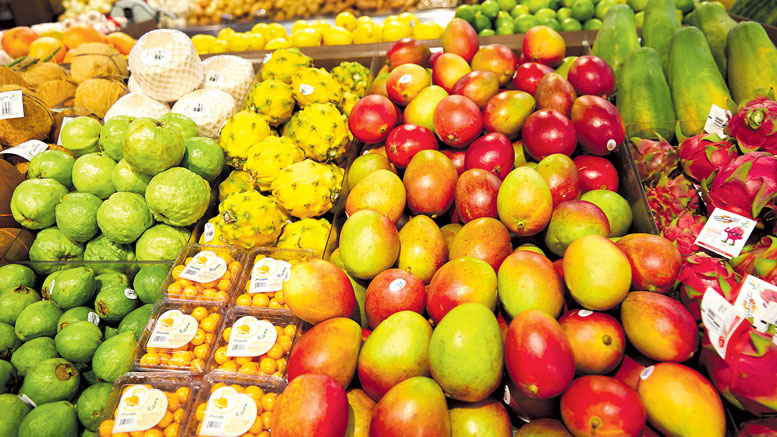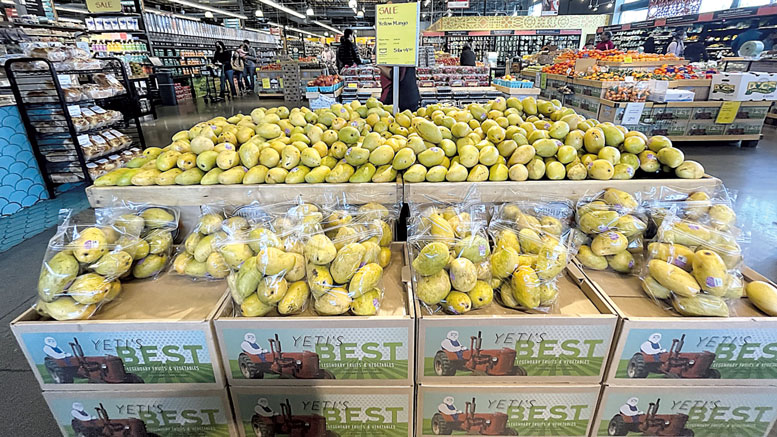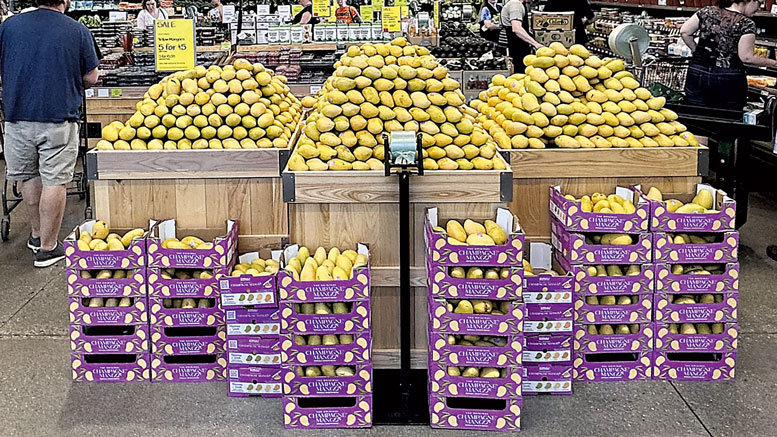The Sweet Taste of Success
January 30, 2024 | 6 min to read
Consumers are increasingly interested in tropical fruits, which present restaurants and retailers a chance to create a new category in produce. While familiar with fruits like mangos, many shoppers feel intimidated by items like jackfruit and dragon fruit. Education through effective merchandising, in-store sampling, and employee training is essential to enhance consumer confidence and drive demand. The National Mango Board exemplifies successful strategies to promote mango usage, potentially paving the way for other tropical fruits.

PHOTO COURTESY J&C TROPICALS
Consumers are hungry for information about versatile tropical foods.
Originally printed in the January 2024 issue of Produce Business.Tropical fruits offer savvy retailers the opportunity to build an entirely new category in produce with consistent effort.
The growing populations from Asia and Latin America provide a core consumer group already familiar with these fruits and how to use them, and the mainstream can be attracted by the nutritional and culinary versatility of these exotic treats.
The challenge is that many consumers are intimidated by produce displays of unfamiliar items such as papayas, coconuts, sapodilla, dragon fruit and jackfruit.
MANGOS LEAD THE WAY
Mangos are the poster fruit for building a customer base for a previously unfamiliar fruit over a period of decades. Worldwide mango consumption has recently grown faster than any other tropical fruit.
Global exports of fresh mangos, mangosteens and guavas were estimated to grow to 2 million tons in 2019, an increase of 23% from the previous year, according to United Nations Food and Agriculture Organization estimates. “This places the commodity cluster as the fastest-growing group among the major tropical fruits in 2019.”
At the turn of the century, U.S. mango consumption was just 1.75 pounds per person per year, according to U.S. Department of Agriculture (USDA) statistics, but it has increased steadily to reach 3.75 pounds per person in 2022. Much of that is due to the work of the National Mango Board, which has taken the lead in helping retailers educate U.S. consumers about how to choose, cut, and use mangos.
The Orlando, FL-based Mango Board works with more than 100 retailer partners to develop and implement programs to help consumers learn how to tell when mangos are ripe, and how to cut them and use them. For example, an annual Retailer of the Year award is given to a retailer that has gone above and beyond in merchandising mangos, an honor that has gone in recent years to Kroger’s, Albertson’s, Wegman’s, ShopRite and Walmart.
“The industry has some resources for retailer education through the National Mango Board,” says Sandra Aguilar, director of marketing and strategic planning at Ciruli Brothers, Rio Rico, AZ. “Ciruli Brothers also provides some resources for back-room handling, including display best practices, ripening guidelines, and instructions on how to cut the fruit.”

PHOTO COURTESY CIRULI BROTHERS
Some suppliers see the doubling of mango consumption since 2000 as just the beginning. “Although popularity and per capita consumption for fresh mangos has increased, it hovers at less than 4 pounds per capita, which is just a few mangos per year depending on size,” says Aguilar.
“Perhaps the most critical thing we communicate to customers is the role temperature plays on the fruit,” Aguilar says. “Maintaining mangos at the right temperature is essential to ensure consumers have consistent quality and great taste.”
Working with a trusted partner is also key, she adds. “Retailers will want to be able to plan and take advantage of resources to merchandise and educate consumers, as well as promotional volumes to give customers more purchase options.”
Aguilar says retailers have an opportunity to increase demand with new and existing mango shoppers. “Consistent volume and display prominence drives sales. Dependable quality and superb flavor, we believe, drive repeat sales. We need to make sure customers have great experiences eating our fruit so they will want it again and again. We recommend that retailers always have ripe fruit available to take the guesswork out of mango selection.”
Aguilar says point-of-sale signage is also a great tool, especially when shelf space is scarce. Ciruli Brothers recently redeveloped its mango packaging to incorporate more consumer messaging. Boxes are display-ready and feature a ripening guide and QR code.
BUILD YOUR SALES
After mangos, papayas have recently been the fastest-growing tropical fruit. According to USDA’s Agricultural Marketing Service, the U.S. market imported 233,728 tons of fresh papaya in 2022, an increase of 5.8% compared to 2021 and a jump of 26.4% compared to 2020. The bulk of the imports come from Mexico and Guatemala.
Dragon fruit has also grown worldwide, at 3.9% annually since 2017, according to Stellar Market Research, and is forecast to grow at a rate of 6% annually to 2033. Mordor Intelligence forecasts that dragon fruit consumption worldwide will increase from $14.1 billion in 2023 to $17.5 billion in 2028.
“I think dragon fruit will increase; the numbers show it’s soaring,” says Denise Gomez, marketing manager for J&C Tropicals, Miami, FL. “We sell to big grocers like Publix and Walmart.”
J&C Tropicals is the No. 1 distributor of dragon fruit in the country and supplies other tropical fruits, such as mangos, avocados, guavas and rambutan. Nibaldo Capote started J&C Tropicals on 5 acres in Florida in 1965 after leaving Cuba. The family business has grown to ship 70 tropical fruits and vegetables from 10 countries year-round.
To boost retail understanding of tropicals like dragon fruit, the company does trainings with the staff and general manager, says Gomez. “We bring in a chef and do a demo on how to cut and use the fruit. Sometimes we send videos.”
The hard work of bringing consumers to these nutritious, but unfamiliar, fruits happens in produce department stores around the country.

PHOTO COURTESY CIRULI BROTHERS
“In-store sampling and engaging consumers at the point of purchase are the best ways to educate consumers on how to use tropicals,” says Eric Ziegenfuss, category director for tropicals at Oppy, Coquitlam, British Columbia.
SHOW THEM, AND THEY WILL BUY
Mangos have modeled the way for other tropical fruits to enjoy growth.
“The best way for papayas, coconuts, sapodilla, dragon fruit and jackfruit to join mangos and break into the mainstream is consumer education,” says Ziegenfuss.
And that consumer education often starts with employee training about tropicals.
“I would have to assume that many retail employees do not have the proper education and training on some of the specialty tropical items or how to use them,” says Ziegenfuss. “Since they are lower volume items, I could see retailers more focused on higher volume items like bananas, grapes and apples.”
Jackfruit is a nutritional powerhouse, according to the Cleveland Clinic, fighting inflammation, promoting healing, and offering a cholesterol-free source of protein. Increased sales are expected to come as more consumers look for healthy sources of protein, because jackfruit can be substituted for meats in many recipes.
The catch is that a single jackfruit can be 3 feet long and weighs more than 100 pounds, which would make it a challenge for most consumers to get it into a shopping cart, let alone to the car with the rest of their groceries. Fresh jackfruit also does not store easily.
There are, fortunately, peeled and cut jackfruit products offered in cans or pouches. And, according to longtime produce consultant Dick Spezzano, some Asian specialty markets avoid this problem by merchandising jackfruit already cut. That option, however, requires learning from your supplier how to handle cut jackfruit so that it looks fresh at retail.
The tropical category is evolving and even large suppliers like Oppy, which offers more than 100 different produce items, do not have all the specialty tropical items. “Our tropical category consists of kiwi, mangos, pomegranates and pineapples,” says Ziegenfuss. “A lot of the items are not in our catalog.”
Mainstream retailers might do well to go down the street or across town to see how markets catering to Asian or Hispanic consumers are merchandising specialty tropical produce items.
“I notice a small presence of these specialty items in all stores, but I find that small niche stores do a better job of merchandising these unique items,” says Ziegenfuss.
1 of 32 article in Produce Business January 2024

